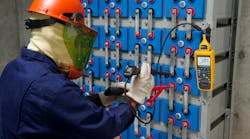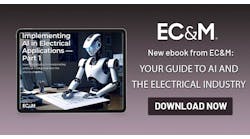Testing Storage Batteries Vs. Energy Storage Systems
This article was written by technical expert Sean White for Fluke Corp.
Batteries can be a reassuring backup for residential and commercial buildings when grid power goes down, and they’re critical to the reliability of wind and solar power systems. Appropriate testing and maintenance are key to ensuring that a battery system is ready when needed.
The differences between a traditional storage battery and an energy storage system (ESS) require different ways of testing the equipment. Unlike traditional storage batteries, often the battery cells in an ESS are not directly accessible. It’s good safety practice to be aware of the relevant codes and standards that apply to storage batteries and ESSs as well as the variety of testing methods you may need for the specific system you’re working on.
Is it a storage battery or an ESS?
Storage batteries are usually just rechargeable lead-acid or nickel-cadmium batteries without electronic controls. You can generally test these batteries directly (Photo 1).
ESSs, on the other hand, are protected with electronics, which can include inverter/chargers (referred to most often in the industry simply as “inverters”), charge controllers, and battery management systems (BMS). These systems don’t usually allow direct access to the batteries themselves.
Multiple codes apply to storage batteries and ESSs
There are multiple codes to consider when working with storage batteries versus ESSs.
- The National Electrical Code (NEC) contains the rules for installing electrical systems in the U.S. and elsewhere. Article 480 applies to Storage Batteries; a newer Article 706 applies to Energy Storage Systems and their batteries.
- The International Code Council (ICC) sets what are often referred to simply as the “building codes.” The ICC’s International Residential Code (IRC) applies to single-family and duplex dwellings; the International Building Code and International Fire Code apply to all other structures.
In North America, products and equipment must also meet UL safety standards. The main UL standard for ESSs is UL 9540. The IRC requires that stationary storage battery systems for single-family and duplex dwellings be UL 9540 compliant. Currently, no lead-acid batteries are part of a UL 9540-listed system.
How to test traditional storage batteries
Batteries need the appropriate voltage and current inputs. A voltage that’s too low yields a low state of charge. In lead-acid batteries, a low state of charge leads to sulfation on the internal lead plates, which reduces the battery’s output, decreases its life, and increases maintenance costs.
Test the battery’s state of charge by using a digital multimeter (DMM) to verify voltage and current. If the battery shows a low open-circuit voltage (Voc), you need to charge the battery. (Note: Consistently using a battery’s full capacity will reduce its life.)
Rechargeable lead-acid or nickel-cadmium batteries in large-scale battery systems are generally accessible enough for you to test them directly. In the interest of safety, use a meter rated for a higher voltage than you expect to measure. The procedure is straightforward:
- Set your meter for a voltage that’s higher than you will measure.
- Put the red probe on the positive (+) terminal of the battery.
- Touch the black probe to the negative (-) terminal of the battery.
- Read the meter display.
A good DMM will give you a negative reading if you’ve reversed the probes. Checking the polarity is important, since connecting a battery in reverse polarity to your equipment can cause significant damage and/or injury.
The batteries used in ESSs
Today, lithium-ion (Li-ion) batteries are the primary storage components in an ESS. According to the U.S. Energy Information Administration, nearly all the utility-scale battery systems installed in the United States since 2014 use lithium-ion technology (Photo 2). These batteries have many advantages: they’re lightweight with high-energy density (energy per volume) and high specific energy (energy per weight). However, Li-ion chemistry also needs to be monitored and controlled by a battery management system (BMS) to prevent thermal runaway — a dangerous positive feedback loop in which excessive heat generates additional heat and can lead to catastrophic battery damage and/or fire. An ESS with BMS control is much safer than an array of storage batteries without built-in protection.
There are many types of ESSs, including:
- “AC batteries” combine battery and inverter into a single unit that outputs AC electricity.
- Other units have a DC battery unit that connects to a special compatible battery inverter to create the ESS. This battery unit-inverter combination must be UL tested together as a unit, and the battery itself also has to be UL 1973 listed and tested separately. (Note: There are currently no UL 9540-listed ESSs that are DC only.)
The only ESS that usually provides direct access to measure the battery voltage is one without an internal DC-to-DC converter. These batteries have an OFF switch or circuit breaker and a BMS. Depending on the specific design (and the manufacturer’s documentation), you may be able to measure the battery voltage on terminals on the ESS; however, you won’t be able to see or touch the batteries. Always follow the manufacturer’s instructions.
These batteries without DC-to-DC converters often use lithium iron phosphate (abbreviated as either LFP or LiFePo) chemistry. An LFP battery is less sensitive to overcharging and thermal runaway than other Li-ion batteries; it also has a lower energy density and specific energy. With a lead-acid battery, 24 cells in series equal 48V nominal. With LFP batteries, 16 cells in series equal 51.2V nominal, so the voltage is close enough that you’ll see 51.2V LFP batteries being referred to as 48V batteries. This is the most common voltage for LFP batteries without internal ESS DC-to-DC converters.
Testing batteries in an ESS with a clamp meter
Most ESSs have unique configurations. They’re controlled by proprietary software, and the batteries are located behind electronics (DC-to-DC converters and/or inverters). Voltage information for this type of ESS can take many forms: an LCD display, a smartphone app, or online access.
One way to confirm that any battery or ESS is operating is to measure current with your clamp meter. You can do this with AC or DC circuits when the wiring is available. The DC circuit wiring isn’t accessible for an installer to test with an AC battery; however, when you’re wiring the DC battery part of an ESS separately from the inverter, you’ll be connecting current-carrying conductors from the battery unit to the inverter.
You can measure the current on an operating (charging or discharging) battery or ESS with a clamp meter:
- Make sure you have safe access to a single wire, where you can fit the clamp around the wire without contacting any energized bare metal, such as terminals.
- Turn the selector to either AC or DC to be measured with the clamp.
- Put the clamp around the single wire you want to measure.
- Read the measurement in amps (A).
Note that if the battery is connected but is neither charging nor discharging, no current is measured. That can also be the case where the current is so small that its output is insignificant or below your clamp meter’s measurement capabilities, such as when the battery is fully charged and being float charged or when the battery is being used to charge only a very small load like a phone.
Never open an ESS component unless it’s specifically allowed by the manufacturer. Besides voiding the warranty, you risk damage to the product or injury to yourself.
Be prepared
Testing and maintenance are key to getting the best performance from any battery system, whether traditional storage batteries or an ESS — but testing for those two battery types differs substantially. By understanding the relevant codes and standards and the variety of testing methods these systems require, you’ll be able to work with any battery system safely and efficiently.
Sean White is a NABCEP Associate Provider and NABCEP Registered Continuing Education provider who teaches customized solar PV courses for NABCEP credit around the world. He has authored eight technical books on Solar PV and Energy Storage, and he’s always working on more. Sean teaches NEC workshops for SPI, Intersolar, and various other entities. He was named the 2014 IREC Trainer of the year and honored as the SNEC Online Trainer of the Decade in 2020.






